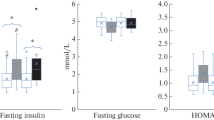In order to identify changes in the blood proteome of healthy volunteers after passive tilt test carried out on day 19 of head-down bed rest, a chromato-mass-spectrometric analysis of samples of dried blood spots was carried out. It was revealed that the body’s response to the tilt test was characterized by a decrease in the level of HDL and kininogen-1. After the tilt test, we observed an increase in the level of vimentin, vitamin K-dependent protein C, Wnt signaling pathway proteins, proteins involved in autophagy and adaptive immune response, focal adhesion proteins, vascular damage marker S100A8, PEDF regulator, and some proteins of the heart: cardiac actin ACTC1 and transcription factor GATA4. The obtained results lay the foundation for future research in the framework of identifying the risks of developing cardiovascular changes in astronauts after space flights.
Similar content being viewed by others
References
Perhonen MA, Zuckerman JH, Levine BD. Deterioration of left ventricular chamber performance after bed rest: “cardiovascular deconditioning” or hypovolemia? Circulation. 2001;103(14):1851-1857. https://doi.org/10.1161/01.cir.103.14.1851
Wood KN, Murray KR, Greaves DK, Hughson RL. Inflight leg cuff test does not identify the risk for orthostatic hypotension after long-duration spaceflight. NPJ Microgravity. 2019;5:22. https://doi.org/10.1038/s41526-019-0082-3
Fu Q, Witkowski S, Levine BD. Vasoconstrictor reserve and sympathetic neural control of orthostasis. Circulation. 2004;110(18):2931-2937. https://doi.org/10.1161/01.CIR.0000146384.91715.B5
Eckberg DL, Halliwill JR, Beightol LA, Brown TE, Taylor JA, Goble R. Human vagal baroreflex mechanisms in space. J. Physiol. 2010;588(Pt 7):1129-1138. https://doi.org/10.1113/jphysiol.2009.186650
Hirayanagi K, Kamiya A, Iwase S, Mano T, Sasaki T, Oinuma M, Yajima K. Autonomic cardiovascular changes during and after 14 days of head-down bed rest. Auton. Neurosci. 2004;110(2):121-128. https://doi.org/10.1016/j.autneu.2004.01.001
NASA Human Research Roadmap. URL: https://humanresearchroadmap.nasa.gov/risks/
Kashirina DN, Brzhozovskiy AG, Sun W, Pastushkova LK, Popova OV, Rusanov VB, Nikolaev EN, Larina IM, Kononikhin AS. Proteomic characterization of dry blood spots of healthy women during simulation the microgravity effects using dry immersion. Front. Physiol. 2022;12:753291. https://doi.org/10.3389/fphys.2021.753291
Quiles JM, Narasimhan M, Mosbruger T, Shanmugam G, Crossman D, Rajasekaran NS. Identification of transcriptome signature for myocardial reductive stress. Redox Biol. 2017;13:568-580. https://doi.org/10.1016/j.redox.2017.07.013
Oka T, Maillet M, Watt AJ, Schwartz RJ, Aronow BJ, Duncan SA, Molkentin JD. Cardiac-specific deletion of Gata4 reveals its requirement for hypertrophy, compensation, and myocyte viability. Circ. Res. 2006;98(6):837-845. https://doi.org/10.1161/01.RES.0000215985.18538.c4
Leurs P, Lindholm B. The AGE-RAGE pathway and its relation to cardiovascular disease in patients with chronic kidney disease. Arch. Med. Res. 2013;44(8):601-610. https://doi.org/10.1016/j.arcmed.2013.11.002
Croce K, Gao H, Wang Y, Mooroka T, Sakuma M, Shi C, Sukhova GK, Packard RR, Hogg N, Libby P, Simon DI. Myeloid-related protein-8/14 is critical for the biological response to vascular injury. Circulation. 2009;120(5):427-436. https://doi.org/10.1161/CIRCULATIONAHA.108.814582
Morikawa-Ichinose T, Fujimura Y, Kumazoe M, Onda H, Miura D, Tachibana H. Inflammatory markers S100A8/A9 and metabolic alteration for evaluating signs of early phase toxicity of anticancer agent treatment. Food Chem. Toxicol. 2022;169:113421. https://doi.org/10.1016/j.fct.2022.113421
Zhang H, Wang Z, Feng SJ, Xu L, Shi HX, Chen LL, Yuan GD, Yan W, Zhuang W, Zhang YQ, Zhang ZM, Dong HY. PEDF improves cardiac function in rats with acute myocardial infarction via inhibiting vascular permeability and cardiomyocyte apoptosis. Int. J. Mol. Sci. 2015;16(3):5618-5634. https://doi.org/10.3390/ijms16035618
Westby CM, Martin DS, Lee SM, Stenger MB, Platts SH. Left ventricular remodeling during and after 60 days of sedentary head-down bed rest. J. Appl. Physiol. (1985). 2016;120(8):956-964. https://doi.org/10.1152/japplphysiol.00676.2015
Author information
Authors and Affiliations
Corresponding author
Additional information
Translated from Byulleten’ Eksperimental’noi Biologii i Meditsiny, Vol. 176, No. 9, pp. 380-385, September, 2023
Rights and permissions
Springer Nature or its licensor (e.g. a society or other partner) holds exclusive rights to this article under a publishing agreement with the author(s) or other rightsholder(s); author self-archiving of the accepted manuscript version of this article is solely governed by the terms of such publishing agreement and applicable law.
About this article
Cite this article
Kashirina, D.N., Pastushkova, L.K., Kononikhin, A.S. et al. Influence of a Passive Tilt Test on the Proteomic Composition of the Blood of Healthy Humans. Bull Exp Biol Med 176, 394–398 (2024). https://doi.org/10.1007/s10517-024-06031-0
Received:
Published:
Issue Date:
DOI: https://doi.org/10.1007/s10517-024-06031-0




